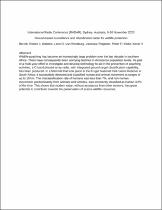JavaScript is disabled for your browser. Some features of this site may not work without it.
- ResearchSpace
- →
- Research Publications/Outputs
- →
- Book Chapters
- →
- View Item
| dc.contributor.author |
Berndt, Robert J

|
|
| dc.contributor.author |
Wabeke, Leon O

|
|
| dc.contributor.author |
Van Rensburg, Vanessa

|
|
| dc.contributor.author |
Potgieter, Pieter F

|
|
| dc.contributor.author |
Kloke, Kevin H

|
|
| dc.date.accessioned | 2024-03-19T07:24:42Z | |
| dc.date.available | 2024-03-19T07:24:42Z | |
| dc.date.issued | 2023-11 | |
| dc.identifier.citation | Berndt, R.J., Wabeke, L.O., Van Rensburg, V., Potgieter, P.F. & Kloke, K.H. 2023. Ground-based surveillance and classification radar for wildlife protection. http://hdl.handle.net/10204/13639 . | en_ZA |
| dc.identifier.isbn | 978-1-6654-8278-3 | |
| dc.identifier.uri | DOI: 10.1109/RADAR54928.2023.10371030 | |
| dc.identifier.uri | http://hdl.handle.net/10204/13639 | |
| dc.description.abstract | Wildlife poaching has become an increasingly large problem over the last decade in southern Africa. There have consequently been worrying declines in rhinoceros population levels. As part of a multi-year effort to investigate and develop technology to aid in the prevention of poaching activities, a C-band phased array radar, with integrated ground target classification capability, has been produced. In a field trial that took place in the Kruger National Park Game Reserve in South Africa, it successfully detected and classified human and animal movement at ranges of up to 10 km. The misclassification rate of humans was less than 7%, and non-human movement, predominantly from animals and vehicles, was incorrectly classified as human 3.8% of the time. This shows that modern radar, without assistance from other sensors, has great potential to contribute towards the preservation of scarce wildlife resources. | en_US |
| dc.format | Abstract | en_US |
| dc.language.iso | en | en_US |
| dc.relation.uri | https://www.radar2023.org/ | en_US |
| dc.relation.uri | https://ieeexplore.ieee.org/document/10371030/ | en_US |
| dc.source | International Radar Conference (RADAR), Sydney, Australia, 6-10 November 2023 | en_US |
| dc.subject | Phasedarray radar | en_US |
| dc.subject | Micro-Doppler | en_US |
| dc.subject | Detection | en_US |
| dc.subject | Classification | en_US |
| dc.subject | Poaching | en_US |
| dc.subject | Surveillance | en_US |
| dc.title | Ground-based surveillance and classification radar for wildlife protection | en_US |
| dc.type | Conference Presentation | en_US |
| dc.description.pages | 5 | en_US |
| dc.description.note | ©2023 IEEE. Due to copyright restrictions, the attached PDF file only contains the abstract of the full text item. For access to the full text item, please consult the publisher's website: https://ieeexplore.ieee.org/document/10371030/ | en_US |
| dc.description.cluster | Defence and Security | en_US |
| dc.description.impactarea | Radar and EW Systems | en_US |
| dc.identifier.apacitation | Berndt, R. J., Wabeke, L. O., Van Rensburg, V., Potgieter, P. F., & Kloke, K. H. (2023). Ground-based surveillance and classification radar for wildlife protection. http://hdl.handle.net/10204/13639 | en_ZA |
| dc.identifier.chicagocitation | Berndt, Robert J, Leon O Wabeke, Vanessa Van Rensburg, Pieter F Potgieter, and Kevin H Kloke. "Ground-based surveillance and classification radar for wildlife protection." <i>International Radar Conference (RADAR), Sydney, Australia, 6-10 November 2023</i> (2023): http://hdl.handle.net/10204/13639 | en_ZA |
| dc.identifier.vancouvercitation | Berndt RJ, Wabeke LO, Van Rensburg V, Potgieter PF, Kloke KH, Ground-based surveillance and classification radar for wildlife protection; 2023. http://hdl.handle.net/10204/13639 . | en_ZA |
| dc.identifier.ris | TY - Conference Presentation AU - Berndt, Robert J AU - Wabeke, Leon O AU - Van Rensburg, Vanessa AU - Potgieter, Pieter F AU - Kloke, Kevin H AB - Wildlife poaching has become an increasingly large problem over the last decade in southern Africa. There have consequently been worrying declines in rhinoceros population levels. As part of a multi-year effort to investigate and develop technology to aid in the prevention of poaching activities, a C-band phased array radar, with integrated ground target classification capability, has been produced. In a field trial that took place in the Kruger National Park Game Reserve in South Africa, it successfully detected and classified human and animal movement at ranges of up to 10 km. The misclassification rate of humans was less than 7%, and non-human movement, predominantly from animals and vehicles, was incorrectly classified as human 3.8% of the time. This shows that modern radar, without assistance from other sensors, has great potential to contribute towards the preservation of scarce wildlife resources. DA - 2023-11 DB - ResearchSpace DP - CSIR J1 - International Radar Conference (RADAR), Sydney, Australia, 6-10 November 2023 KW - Phasedarray radar KW - Micro-Doppler KW - Detection KW - Classification KW - Poaching KW - Surveillance LK - https://researchspace.csir.co.za PY - 2023 SM - 978-1-6654-8278-3 T1 - Ground-based surveillance and classification radar for wildlife protection TI - Ground-based surveillance and classification radar for wildlife protection UR - http://hdl.handle.net/10204/13639 ER - | en_ZA |
| dc.identifier.worklist | 27590 | en_US |






